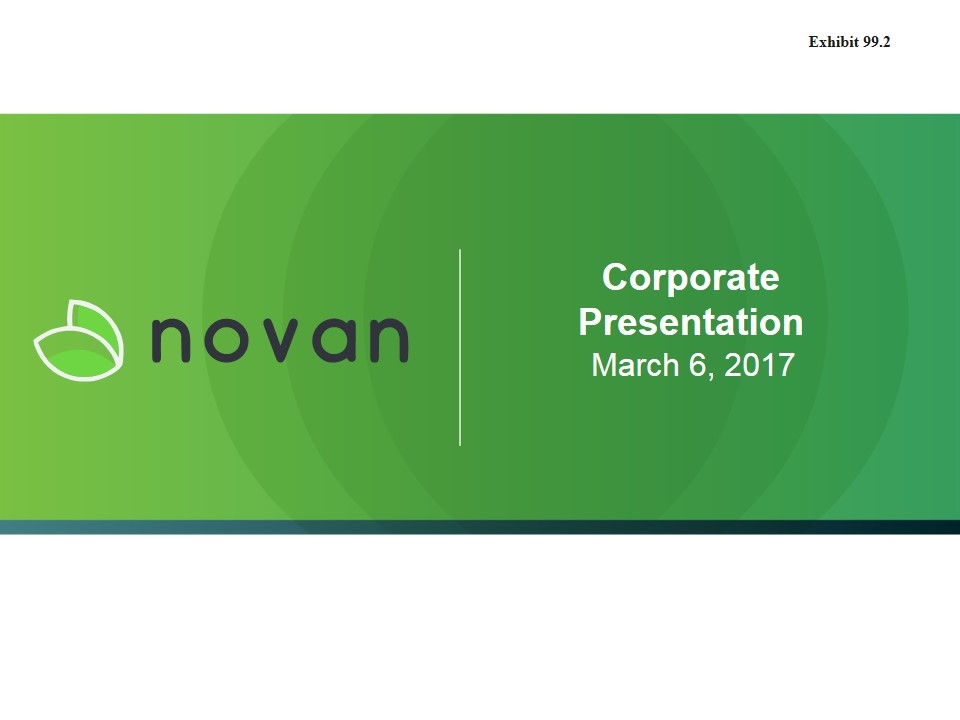
Corporate Presentation March 6, 2017 Exhibit 99.2
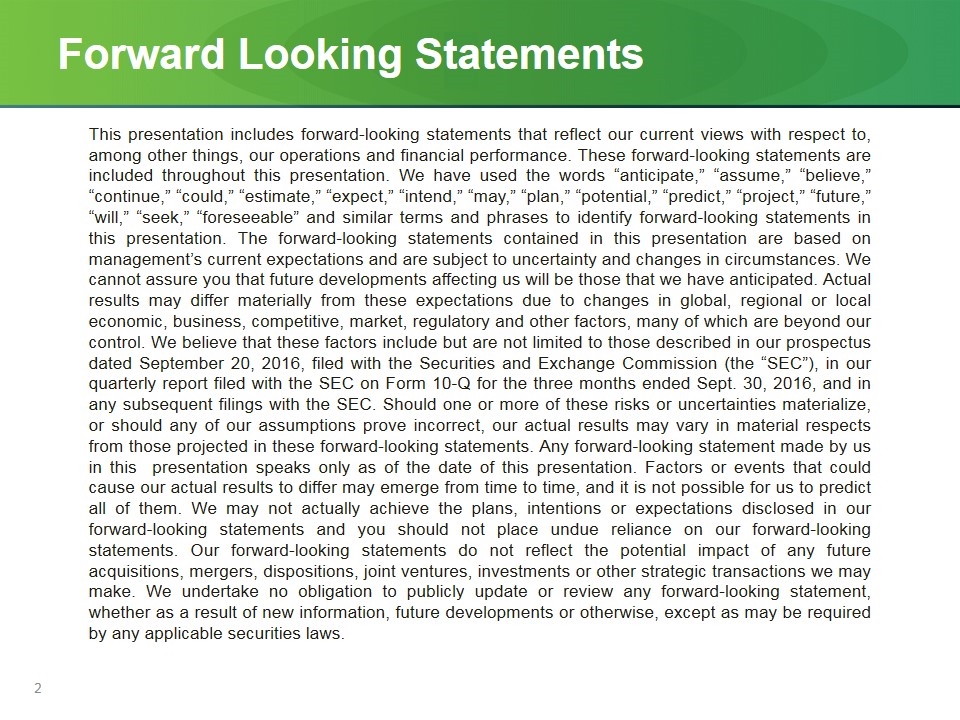
This presentation includes forward-looking statements that reflect our current views with respect to, among other things, our operations and financial performance. These forward-looking statements are included throughout this presentation. We have used the words “anticipate,” “assume,” “believe,” “continue,” “could,” “estimate,” “expect,” “intend,” “may,” “plan,” “potential,” “predict,” “project,” “future,” “will,” “seek,” “foreseeable” and similar terms and phrases to identify forward-looking statements in this presentation. The forward-looking statements contained in this presentation are based on management’s current expectations and are subject to uncertainty and changes in circumstances. We cannot assure you that future developments affecting us will be those that we have anticipated. Actual results may differ materially from these expectations due to changes in global, regional or local economic, business, competitive, market, regulatory and other factors, many of which are beyond our control. We believe that these factors include but are not limited to those described in our prospectus dated September 20, 2016, filed with the Securities and Exchange Commission (the “SEC”), in our quarterly report filed with the SEC on Form 10-Q for the three months ended Sept. 30, 2016, and in any subsequent filings with the SEC. Should one or more of these risks or uncertainties materialize, or should any of our assumptions prove incorrect, our actual results may vary in material respects from those projected in these forward-looking statements. Any forward-looking statement made by us in this presentation speaks only as of the date of this presentation. Factors or events that could cause our actual results to differ may emerge from time to time, and it is not possible for us to predict all of them. We may not actually achieve the plans, intentions or expectations disclosed in our forward-looking statements and you should not place undue reliance on our forward-looking statements. Our forward-looking statements do not reflect the potential impact of any future acquisitions, mergers, dispositions, joint ventures, investments or other strategic transactions we may make. We undertake no obligation to publicly update or review any forward-looking statement, whether as a result of new information, future developments or otherwise, except as may be required by any applicable securities laws. Forward Looking Statements
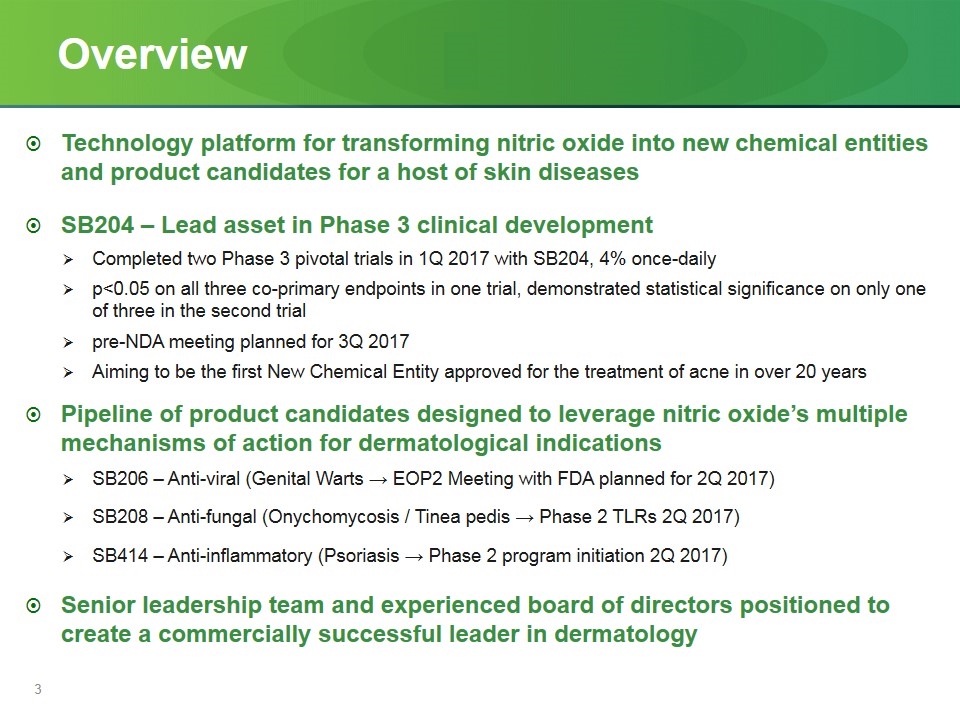
Technology platform for transforming nitric oxide into new chemical entities and product candidates for a host of skin diseases SB204 – Lead asset in Phase 3 clinical development Completed two Phase 3 pivotal trials in 1Q 2017 with SB204, 4% once-daily p<0.05 on all three co-primary endpoints in one trial, demonstrated statistical significance on only one of three in the second trial pre-NDA meeting planned for 3Q 2017 Aiming to be the first New Chemical Entity approved for the treatment of acne in over 20 years Pipeline of product candidates designed to leverage nitric oxide’s multiple mechanisms of action for dermatological indications SB206 – Anti-viral (Genital Warts → EOP2 Meeting with FDA planned for 2Q 2017) SB208 – Anti-fungal (Onychomycosis / Tinea pedis → Phase 2 TLRs 2Q 2017) SB414 – Anti-inflammatory (Psoriasis → Phase 2 program initiation 2Q 2017) Senior leadership team and experienced board of directors positioned to create a commercially successful leader in dermatology Overview
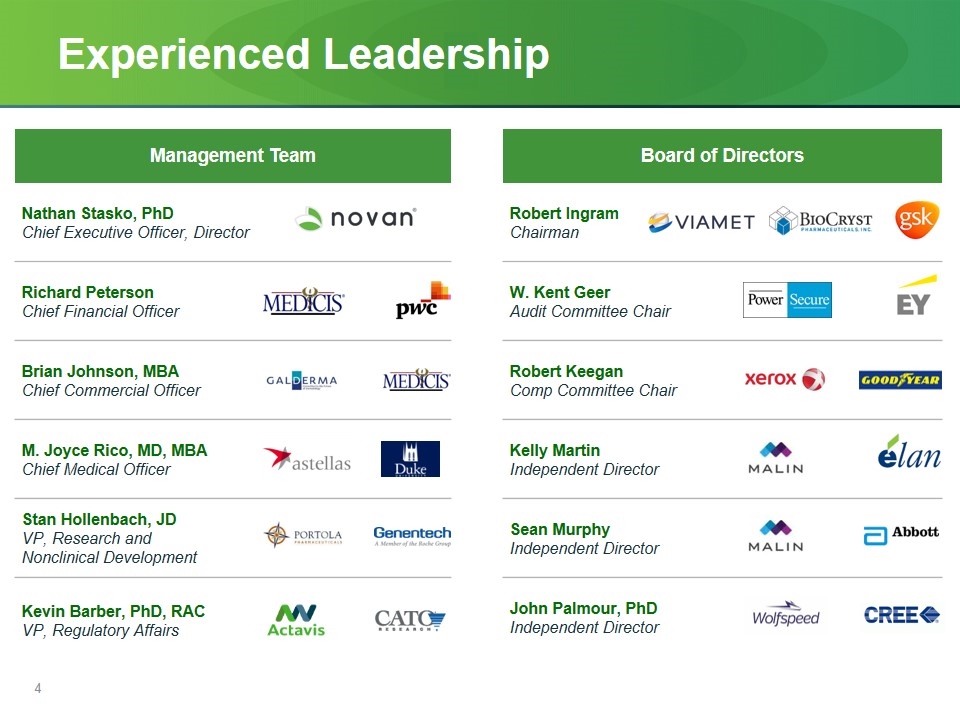
Experienced Leadership Management Team Nathan Stasko, PhD Chief Executive Officer, Director Richard Peterson Chief Financial Officer Brian Johnson, MBA Chief Commercial Officer M. Joyce Rico, MD, MBA Chief Medical Officer Stan Hollenbach, JD VP, Research and Nonclinical Development Kevin Barber, PhD, RAC VP, Regulatory Affairs Board of Directors Robert Ingram Chairman W. Kent Geer Audit Committee Chair Robert Keegan Comp Committee Chair Kelly Martin Independent Director Sean Murphy Independent Director John Palmour, PhD Independent Director
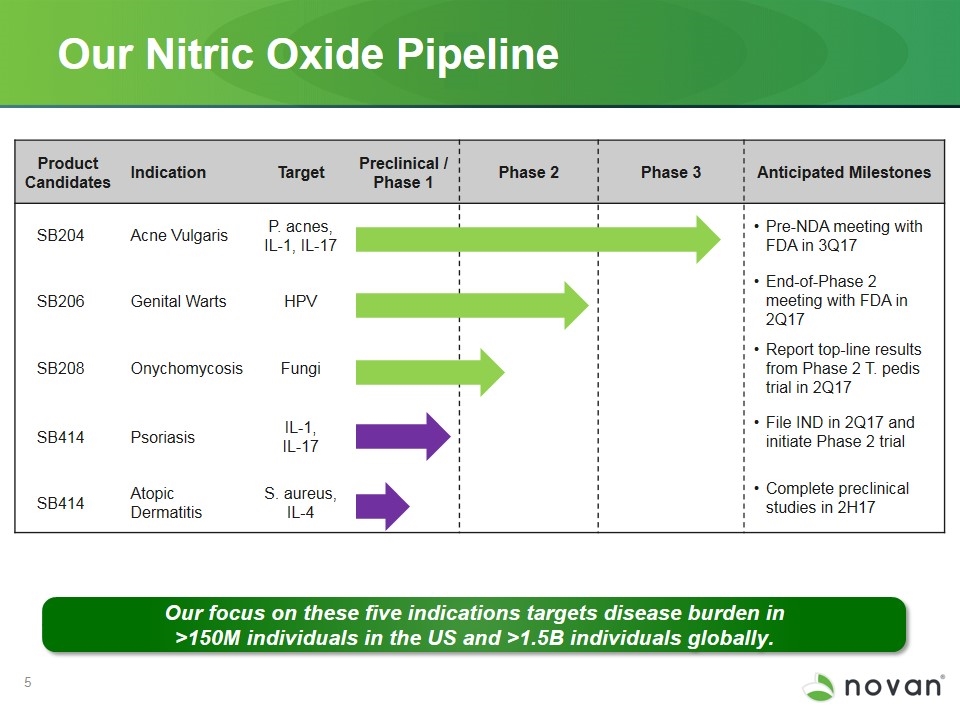
Our Nitric Oxide Pipeline Our focus on these five indications targets disease burden in >150M individuals in the US and >1.5B individuals globally. Product Candidates Indication Target Preclinical / Phase 1 Phase 2 Phase 3 Anticipated Milestones SB204 Acne Vulgaris P. acnes, IL-1, IL-17 Pre-NDA meeting with FDA in 3Q17 SB206 Genital Warts HPV End-of-Phase 2 meeting with FDA in 2Q17 SB208 Onychomycosis Fungi Report top-line results from Phase 2 T. pedis trial in 2Q17 SB414 Psoriasis IL-1, IL-17 File IND in 2Q17 and initiate Phase 2 trial Complete preclinical studies in 2H17 SB414 Atopic Dermatitis S. aureus, IL-4
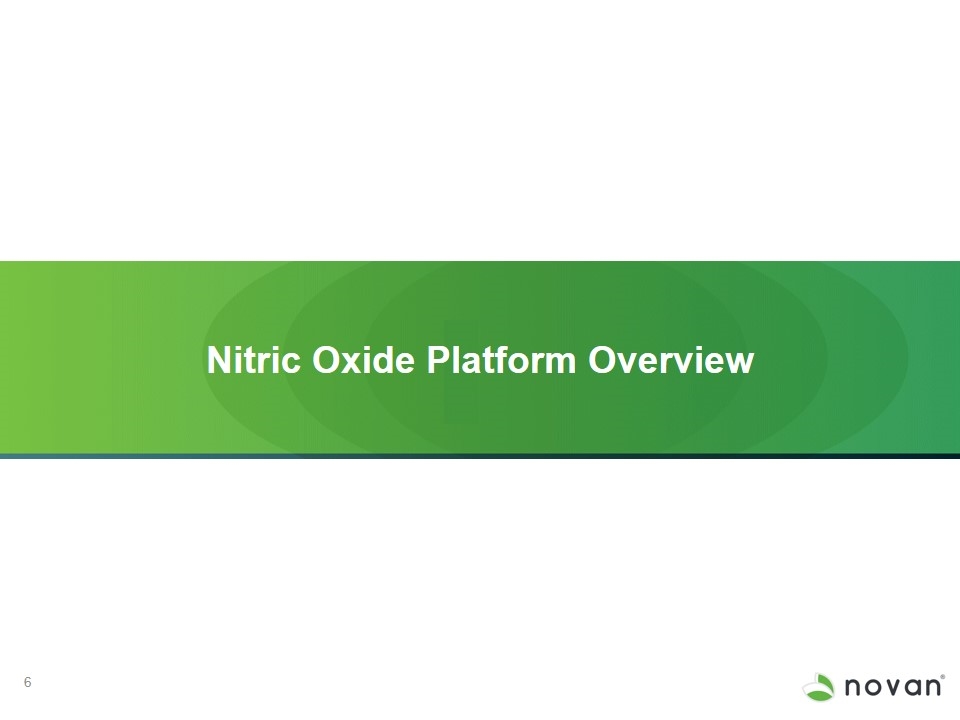
Nitric Oxide Platform Overview
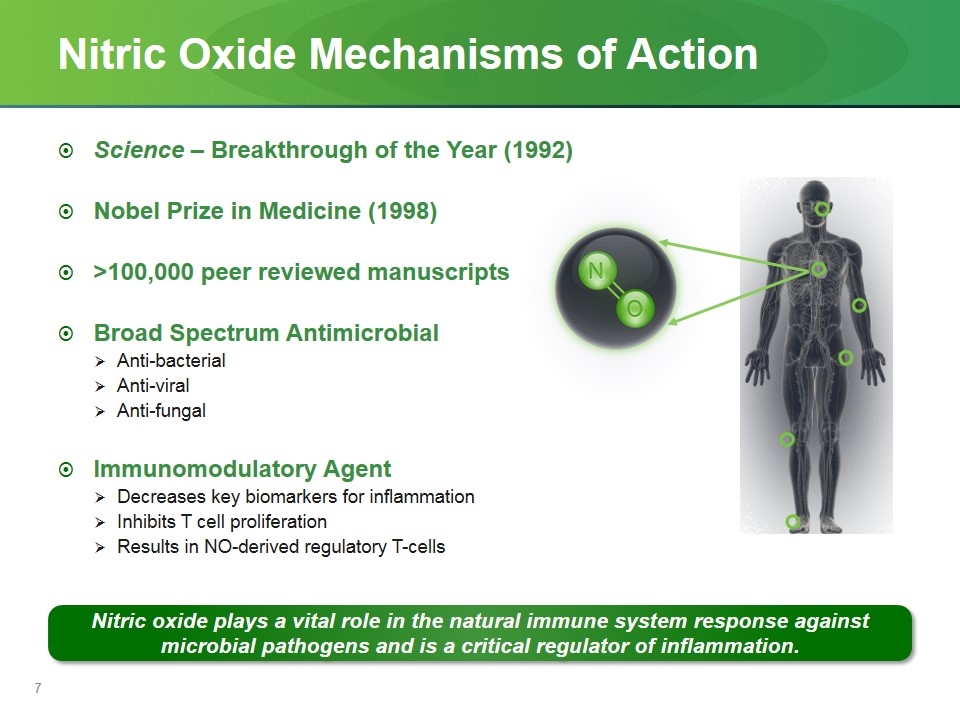
Science – Breakthrough of the Year (1992) Nobel Prize in Medicine (1998) >100,000 peer reviewed manuscripts Broad Spectrum Antimicrobial Anti-bacterial Anti-viral Anti-fungal Immunomodulatory Agent Decreases key biomarkers for inflammation Inhibits T cell proliferation Results in NO-derived regulatory T-cells Nitric Oxide Mechanisms of Action Nitric oxide plays a vital role in the natural immune system response against microbial pathogens and is a critical regulator of inflammation.
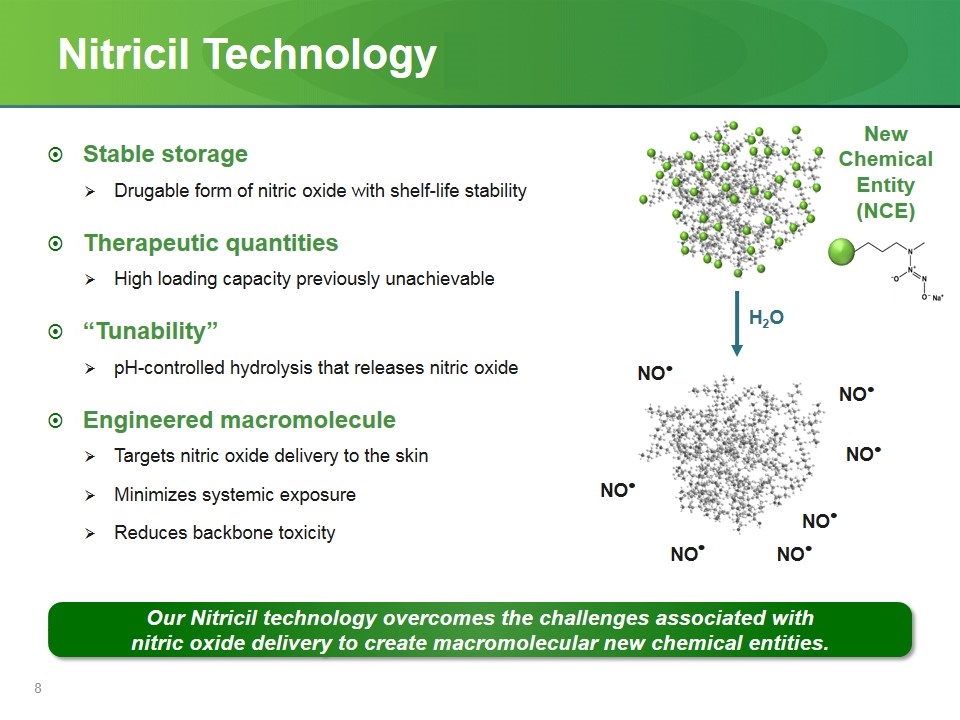
Nitricil Technology Stable storage Drugable form of nitric oxide with shelf-life stability Therapeutic quantities High loading capacity previously unachievable “Tunability” pH-controlled hydrolysis that releases nitric oxide Engineered macromolecule Targets nitric oxide delivery to the skin Minimizes systemic exposure Reduces backbone toxicity Our Nitricil technology overcomes the challenges associated with nitric oxide delivery to create macromolecular new chemical entities. H2O NO . NO . NO . NO . NO . NO . NO . New Chemical Entity (NCE)
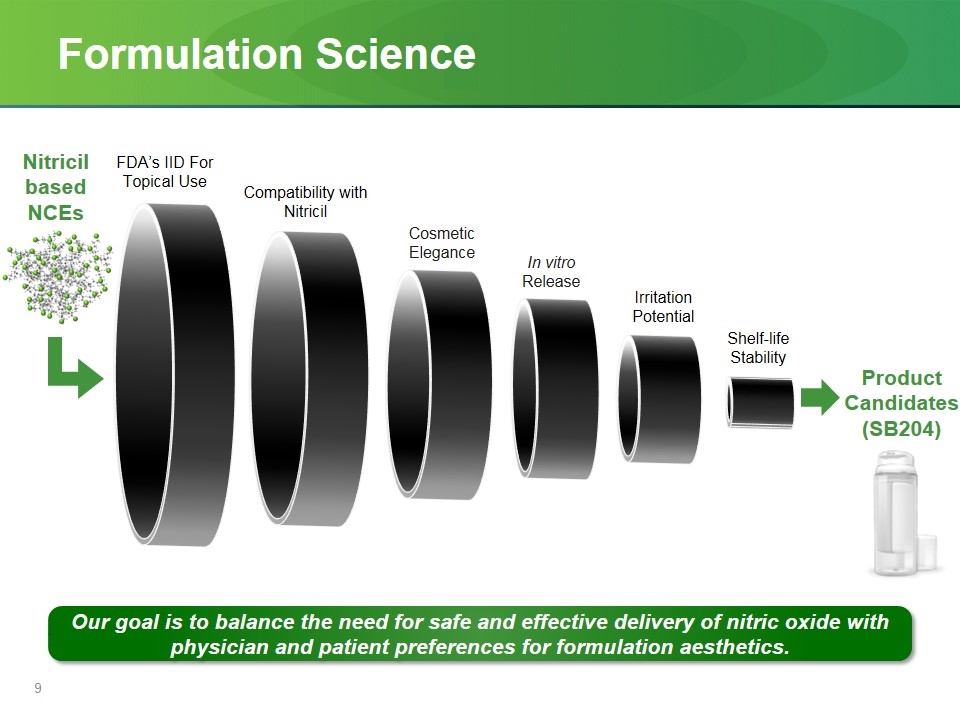
Formulation Science Cosmetic Elegance FDA’s IID For Topical Use Irritation Potential Compatibility with Nitricil In vitro Release Shelf-life Stability Product Candidates (SB204) Nitricil based NCEs Our goal is to balance the need for safe and effective delivery of nitric oxide with physician and patient preferences for formulation aesthetics.
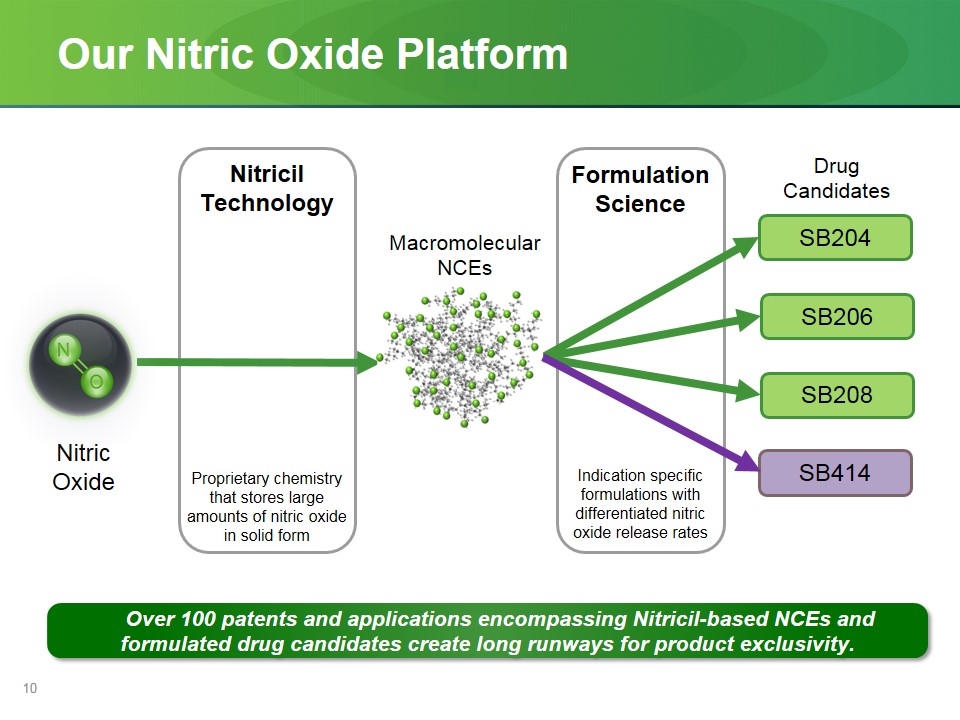
Our Nitric Oxide Platform NVN1000 Nitric Oxide Proprietary chemistry that stores large amounts of nitric oxide in solid form Macromolecular NCEs Drug Candidates Indication specific formulations with differentiated nitric oxide release rates Formulation Science Nitricil Technology SB204 SB206 Over 100 patents and applications encompassing Nitricil-based NCEs and formulated drug candidates create long runways for product exclusivity. SB208 SB414
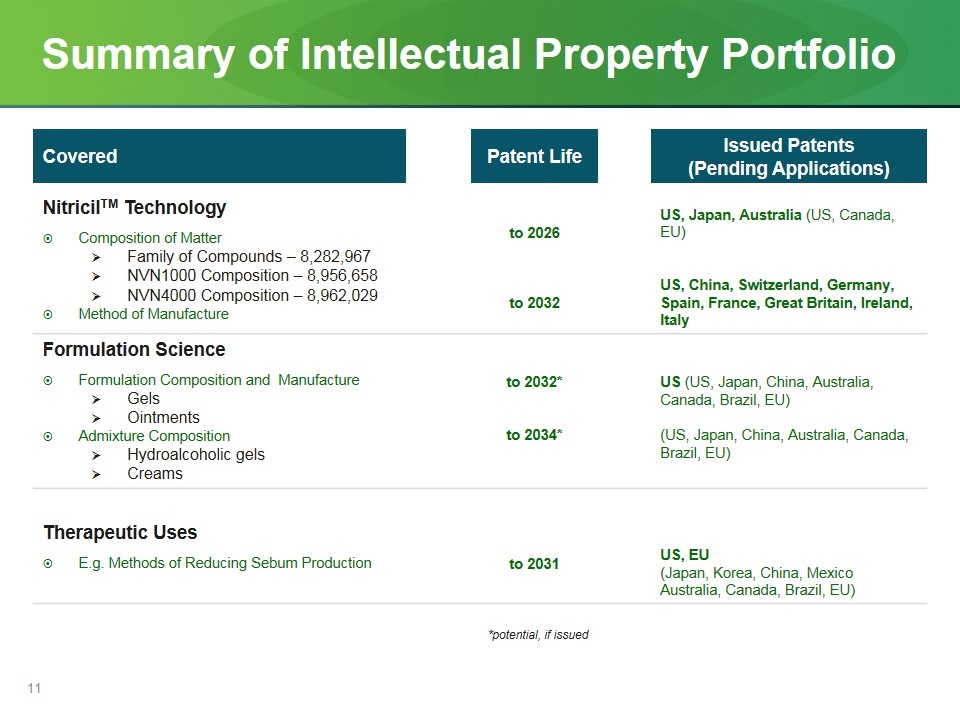
Summary of Intellectual Property Portfolio Covered Patent Life Issued Patents (Pending Applications) NitricilTM Technology Composition of Matter Family of Compounds – 8,282,967 NVN1000 Composition – 8,956,658 NVN4000 Composition – 8,962,029 Method of Manufacture to 2026 to 2032 US, Japan, Australia (US, Canada, EU) US, China, Switzerland, Germany, Spain, France, Great Britain, Ireland, Italy Formulation Science Formulation Composition and Manufacture Gels Ointments Admixture Composition Hydroalcoholic gels Creams to 2032* to 2034* US (US, Japan, China, Australia, Canada, Brazil, EU) (US, Japan, China, Australia, Canada, Brazil, EU) Therapeutic Uses E.g. Methods of Reducing Sebum Production to 2031 US, EU (Japan, Korea, China, Mexico Australia, Canada, Brazil, EU) *potential, if issued
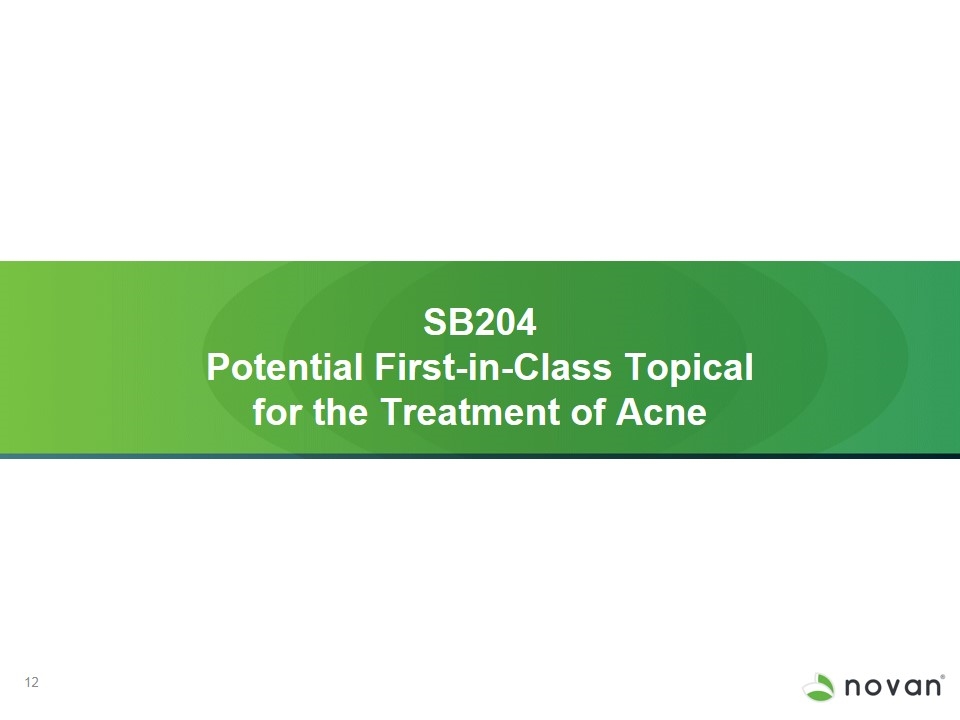
SB204 Potential First-in-Class Topical for the Treatment of Acne
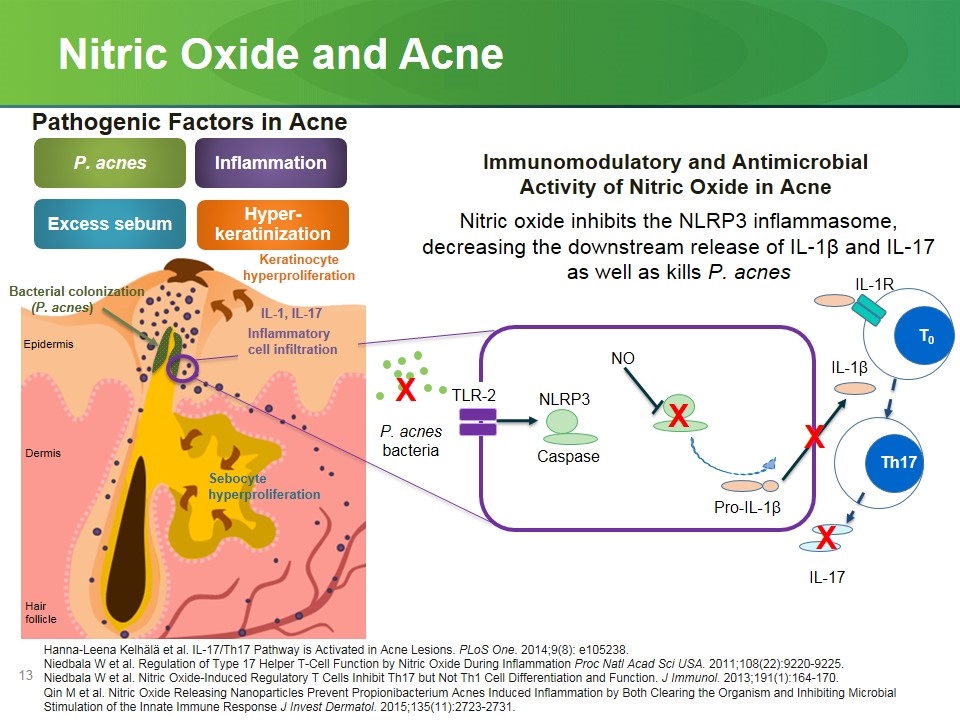
Nitric Oxide and Acne Hanna-Leena Kelhälä et al. IL-17/Th17 Pathway is Activated in Acne Lesions. PLoS One. 2014;9(8): e105238. Niedbala W et al. Regulation of Type 17 Helper T-Cell Function by Nitric Oxide During Inflammation Proc Natl Acad Sci USA. 2011;108(22):9220-9225. Niedbala W et al. Nitric Oxide-Induced Regulatory T Cells Inhibit Th17 but Not Th1 Cell Differentiation and Function. J Immunol. 2013;191(1):164-170. Qin M et al. Nitric Oxide Releasing Nanoparticles Prevent Propionibacterium Acnes Induced Inflammation by Both Clearing the Organism and Inhibiting Microbial Stimulation of the Innate Immune Response J Invest Dermatol. 2015;135(11):2723-2731. P. acnes Excess sebum Inflammation Hyper-keratinization Keratinocyte hyperproliferation Bacterial colonization (P. acnes) Epidermis Dermis Hair follicle Sebocyte hyperproliferation IL-1, IL-17 Pathogenic Factors in Acne NLRP3 Th17 TLR-2 IL-1R P. acnes bacteria IL-17 IL-1β X T0 NO X Pro-IL-1β Immunomodulatory and Antimicrobial Activity of Nitric Oxide in Acne Nitric oxide inhibits the NLRP3 inflammasome, decreasing the downstream release of IL-1β and IL-17 as well as kills P. acnes Inflammatory cell infiltration Caspase X X
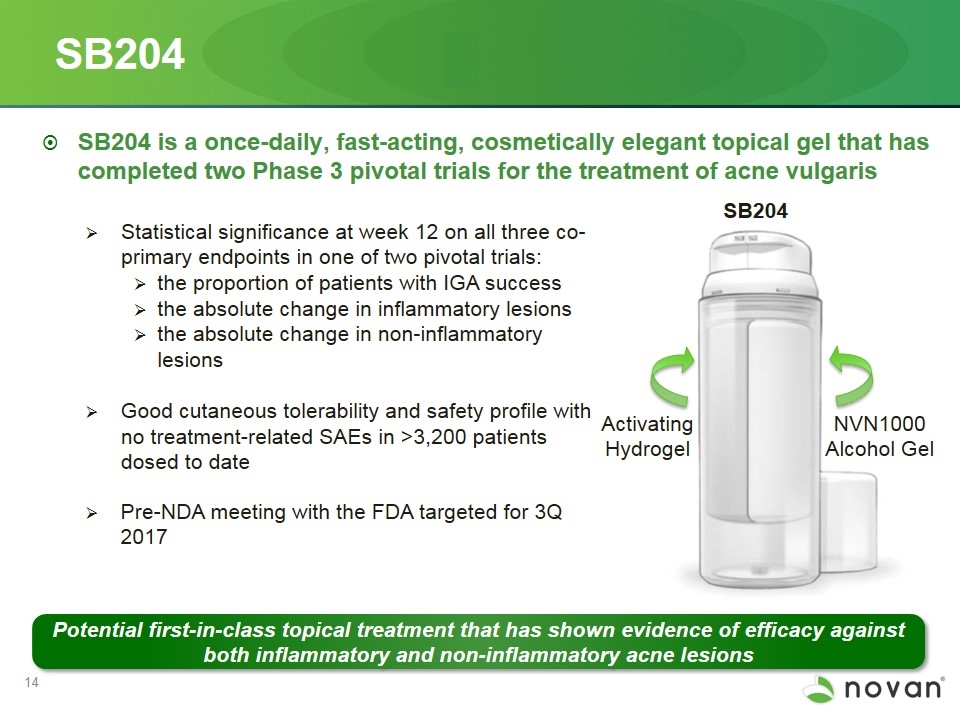
SB204 SB204 Activating Hydrogel NVN1000 Alcohol Gel SB204 is a once-daily, fast-acting, cosmetically elegant topical gel that has completed two Phase 3 pivotal trials for the treatment of acne vulgaris Potential first-in-class topical treatment that has shown evidence of efficacy against both inflammatory and non-inflammatory acne lesions Statistical significance at week 12 on all three co-primary endpoints in one of two pivotal trials: the proportion of patients with IGA success the absolute change in inflammatory lesions the absolute change in non-inflammatory lesions Good cutaneous tolerability and safety profile with no treatment-related SAEs in >3,200 patients dosed to date Pre-NDA meeting with the FDA targeted for 3Q 2017
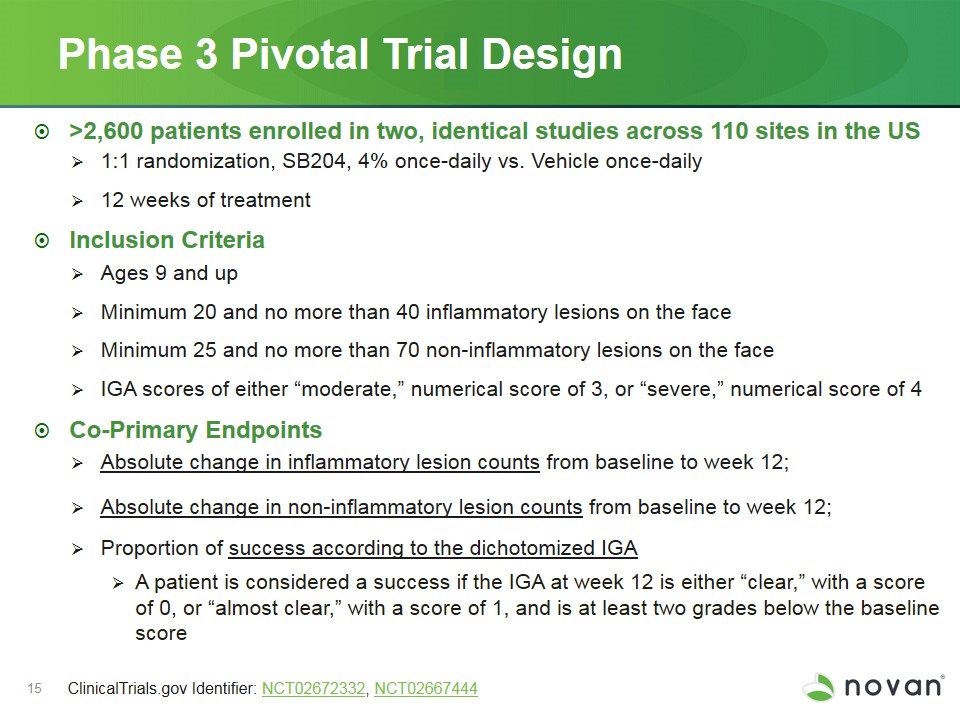
>2,600 patients enrolled in two, identical studies across 110 sites in the US 1:1 randomization, SB204, 4% once-daily vs. Vehicle once-daily 12 weeks of treatment Inclusion Criteria Ages 9 and up Minimum 20 and no more than 40 inflammatory lesions on the face Minimum 25 and no more than 70 non-inflammatory lesions on the face IGA scores of either “moderate,” numerical score of 3, or “severe,” numerical score of 4 Co-Primary Endpoints Absolute change in inflammatory lesion counts from baseline to week 12; Absolute change in non-inflammatory lesion counts from baseline to week 12; Proportion of success according to the dichotomized IGA A patient is considered a success if the IGA at week 12 is either “clear,” with a score of 0, or “almost clear,” with a score of 1, and is at least two grades below the baseline score Phase 3 Pivotal Trial Design ClinicalTrials.gov Identifier: NCT02672332, NCT02667444
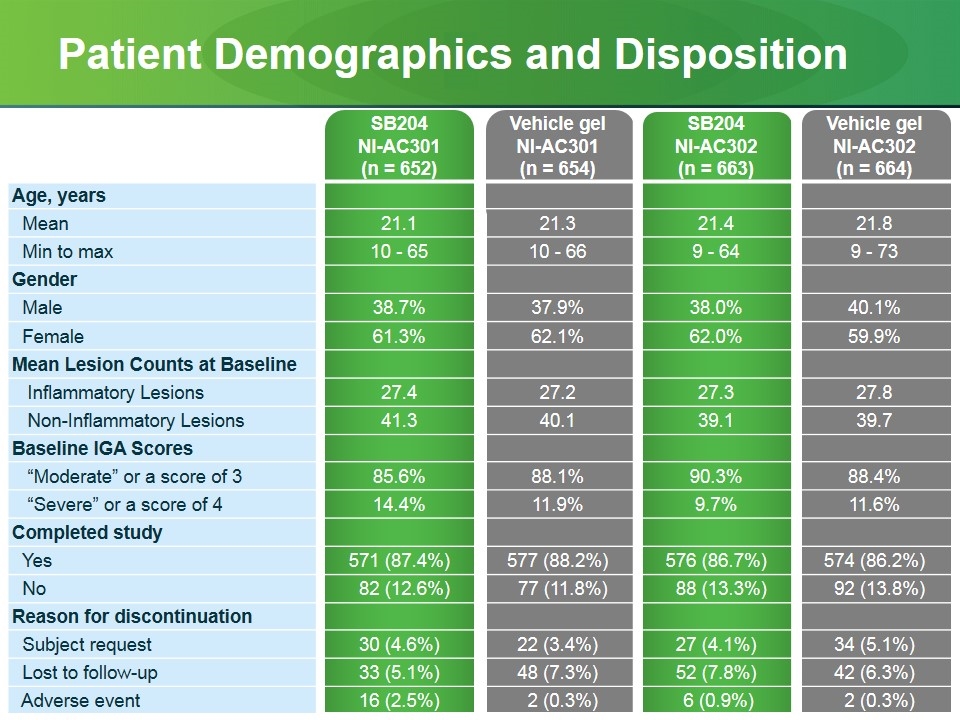
Patient Demographics and Disposition SB204 NI-AC301 (n = 652) Vehicle gel NI-AC301 (n = 654) SB204 NI-AC302 (n = 663) Vehicle gel NI-AC302 (n = 664) Age, years Mean 21.1 21.3 21.4 21.8 Min to max 10 - 65 10 - 66 9 - 64 9 - 73 Gender Male 38.7% 37.9% 38.0% 40.1% Female 61.3% 62.1% 62.0% 59.9% Mean Lesion Counts at Baseline Inflammatory Lesions 27.4 27.2 27.3 27.8 Non-Inflammatory Lesions 41.3 40.1 39.1 39.7 Baseline IGA Scores “Moderate” or a score of 3 85.6% 88.1% 90.3% 88.4% “Severe” or a score of 4 14.4% 11.9% 9.7% 11.6% Completed study Yes 571 (87.4%) 577 (88.2%) 576 (86.7%) 574 (86.2%) No 82 (12.6%) 77 (11.8%) 88 (13.3%) 92 (13.8%) Reason for discontinuation Subject request 30 (4.6%) 22 (3.4%) 27 (4.1%) 34 (5.1%) Lost to follow-up 33 (5.1%) 48 (7.3%) 52 (7.8%) 42 (6.3%) Adverse event 16 (2.5%) 2 (0.3%) 6 (0.9%) 2 (0.3%)
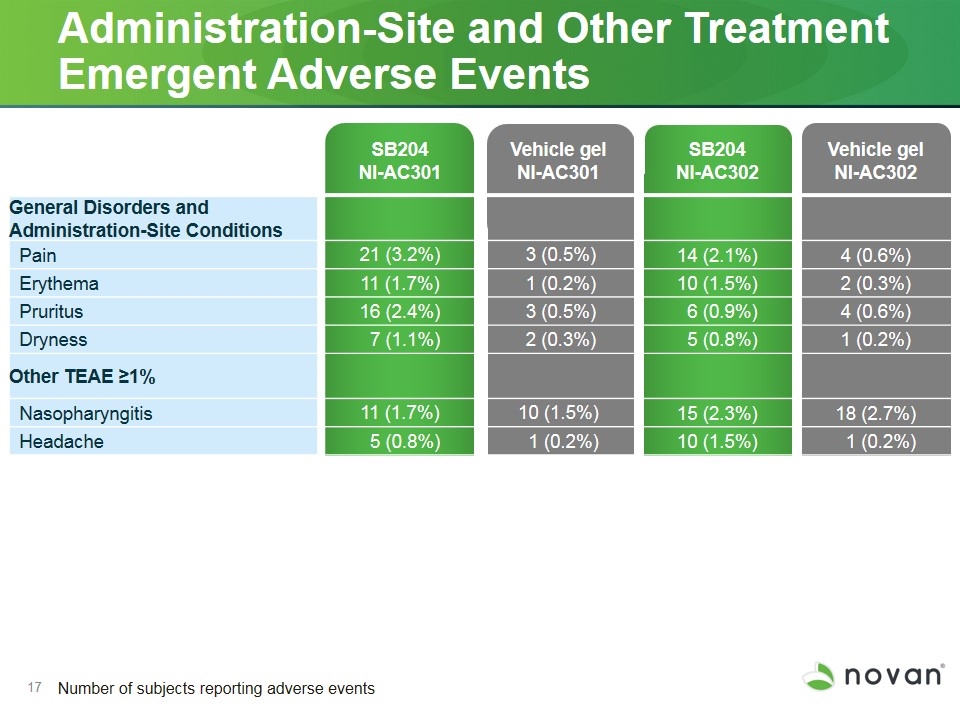
Administration-Site and Other Treatment Emergent Adverse Events SB204 NI-AC301 Vehicle gel NI-AC301 SB204 NI-AC302 Vehicle gel NI-AC302 General Disorders and Administration-Site Conditions Pain 21 (3.2%) 3 (0.5%) 14 (2.1%) 4 (0.6%) Erythema 11 (1.7%) 1 (0.2%) 10 (1.5%) 2 (0.3%) Pruritus 16 (2.4%) 3 (0.5%) 6 (0.9%) 4 (0.6%) Dryness 7 (1.1%) 2 (0.3%) 5 (0.8%) 1 (0.2%) Other TEAE ≥1% Nasopharyngitis 11 (1.7%) 10 (1.5%) 15 (2.3%) 18 (2.7%) Headache 5 (0.8%) 1 (0.2%) 10 (1.5%) 1 (0.2%) Number of subjects reporting adverse events
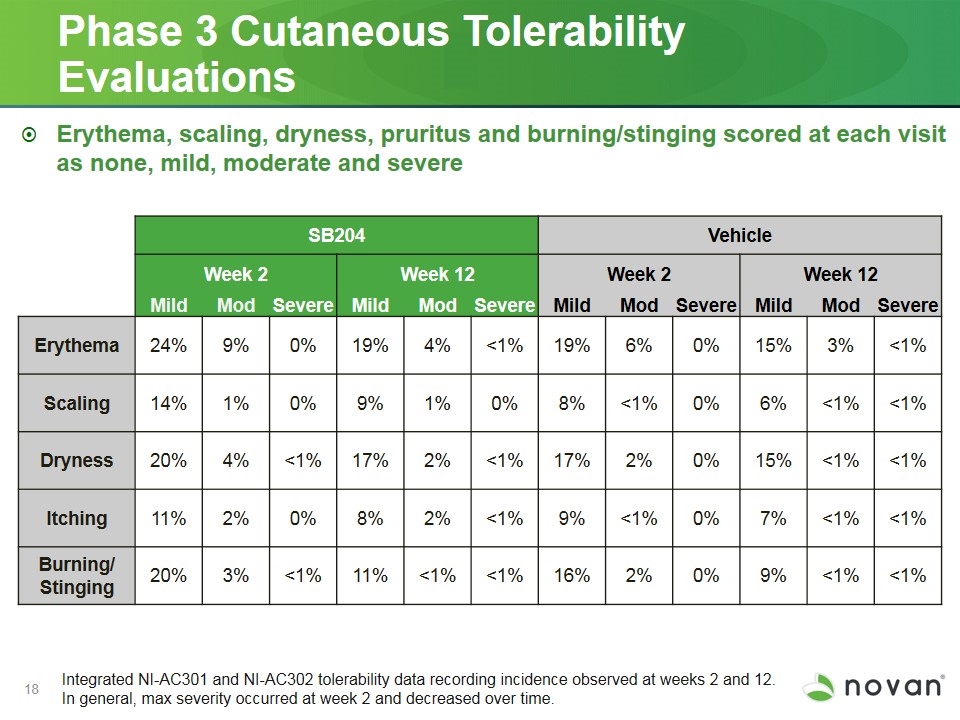
SB204 Vehicle Week 2 Week 12 Week 2 Week 12 Mild Mod Severe Mild Mod Severe Mild Mod Severe Mild Mod Severe Erythema 24% 9% 0% 19% 4% <1% 19% 6% 0% 15% 3% <1% Scaling 14% 1% 0% 9% 1% 0% 8% <1% 0% 6% <1% <1% Dryness 20% 4% <1% 17% 2% <1% 17% 2% 0% 15% <1% <1% Itching 11% 2% 0% 8% 2% <1% 9% <1% 0% 7% <1% <1% Burning/ Stinging 20% 3% <1% 11% <1% <1% 16% 2% 0% 9% <1% <1% Phase 3 Cutaneous Tolerability Evaluations Erythema, scaling, dryness, pruritus and burning/stinging scored at each visit as none, mild, moderate and severe Integrated NI-AC301 and NI-AC302 tolerability data recording incidence observed at weeks 2 and 12. In general, max severity occurred at week 2 and decreased over time.
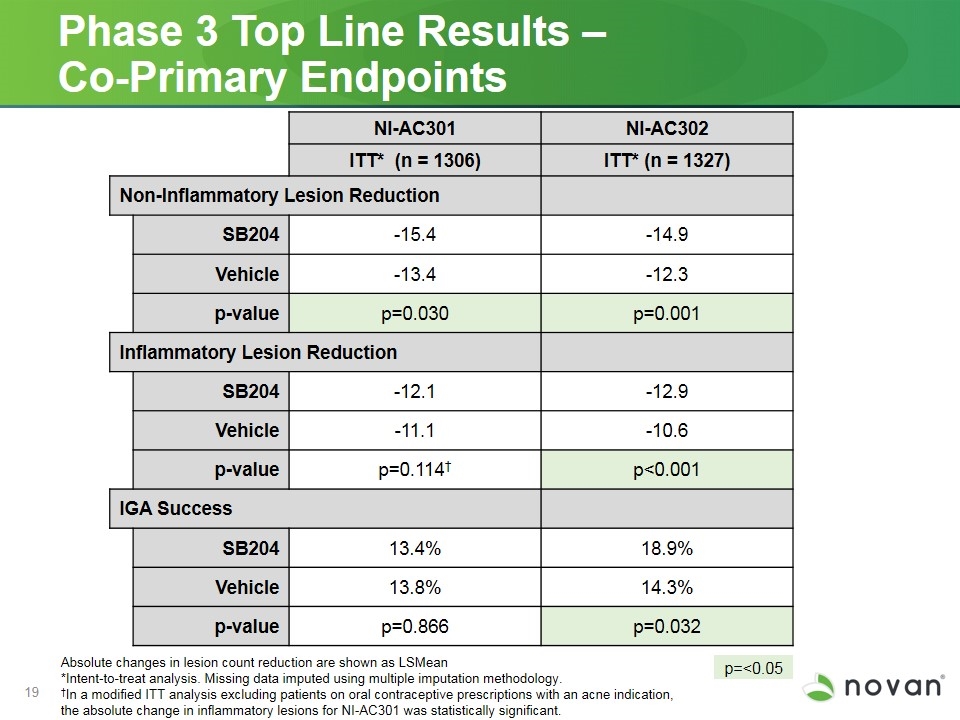
Absolute changes in lesion count reduction are shown as LSMean *Intent-to-treat analysis. Missing data imputed using multiple imputation methodology. †In a modified ITT analysis excluding patients on oral contraceptive prescriptions with an acne indication, the absolute change in inflammatory lesions for NI-AC301 was statistically significant. Phase 3 Top Line Results – Co-Primary Endpoints NI-AC301 NI-AC302 ITT* (n = 1306) ITT* (n = 1327) Non-Inflammatory Lesion Reduction SB204 -15.4 -14.9 Vehicle -13.4 -12.3 p-value p=0.030 p=0.001 Inflammatory Lesion Reduction SB204 -12.1 -12.9 Vehicle -11.1 -10.6 p-value p=0.114† p<0.001 IGA Success SB204 13.4% 18.9% Vehicle 13.8% 14.3% p-value p=0.866 p=0.032 p=<0.05
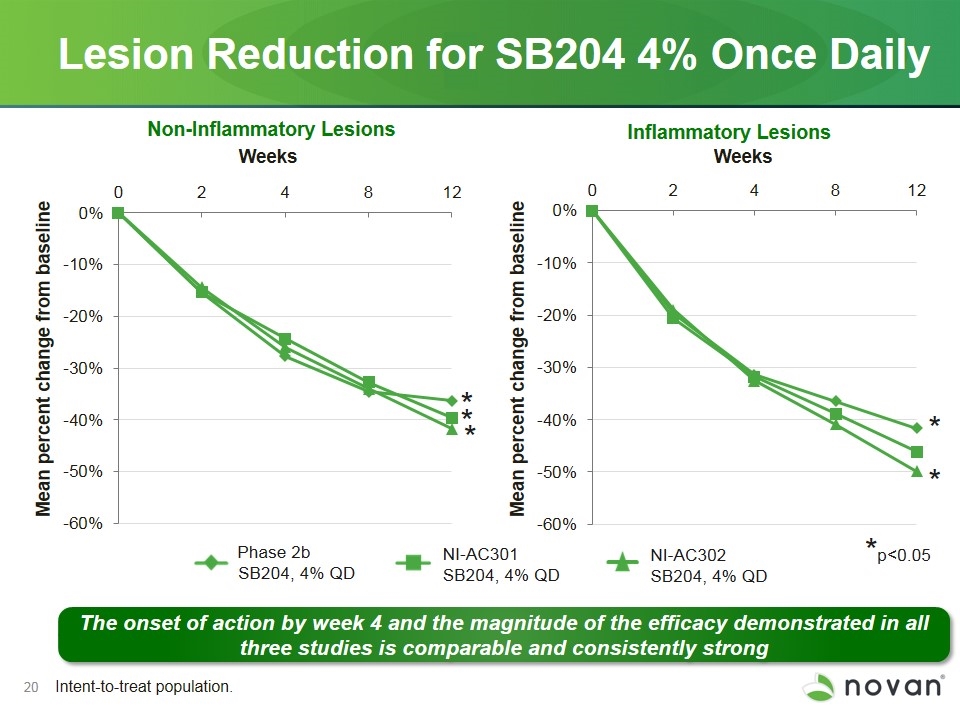
Lesion Reduction for SB204 4% Once Daily Inflammatory Lesions Weeks Mean percent change from baseline Non-Inflammatory Lesions Weeks Mean percent change from baseline Intent-to-treat population. NI-AC302 SB204, 4% QD NI-AC301 SB204, 4% QD Phase 2b SB204, 4% QD The onset of action by week 4 and the magnitude of the efficacy demonstrated in all three studies is comparable and consistently strong * * * * * *p<0.05
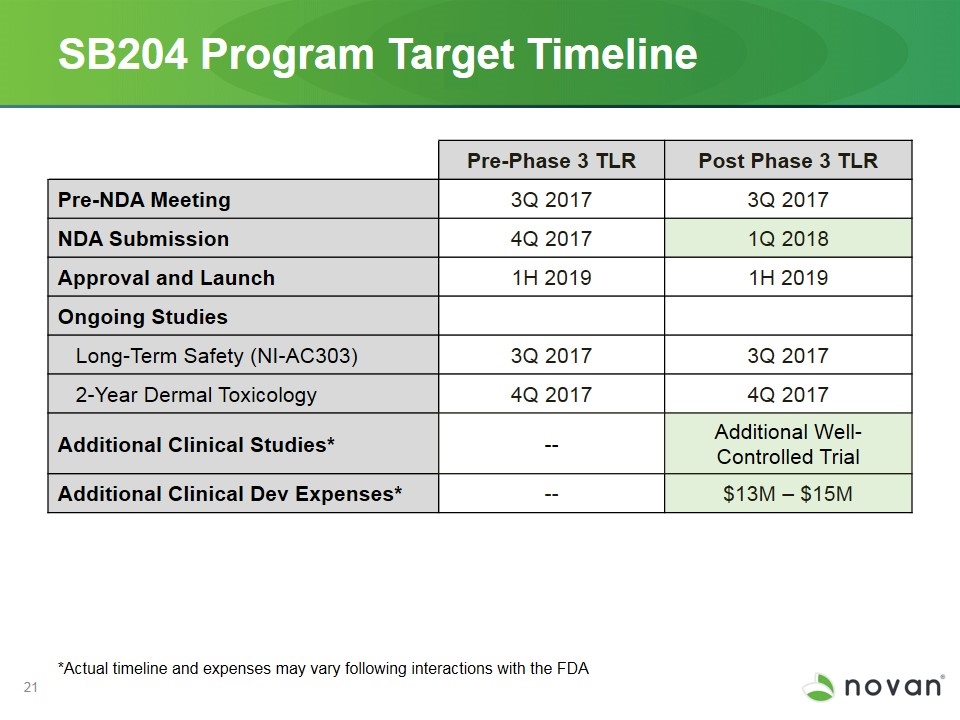
Pre-Phase 3 TLR Post Phase 3 TLR Pre-NDA Meeting 3Q 2017 3Q 2017 NDA Submission 4Q 2017 1Q 2018 Approval and Launch 1H 2019 1H 2019 Ongoing Studies Long-Term Safety (NI-AC303) 3Q 2017 3Q 2017 2-Year Dermal Toxicology 4Q 2017 4Q 2017 Additional Clinical Studies* -- Additional Well-Controlled Trial Additional Clinical Dev Expenses* -- $13M – $15M SB204 Program Target Timeline *Actual timeline and expenses may vary following interactions with the FDA
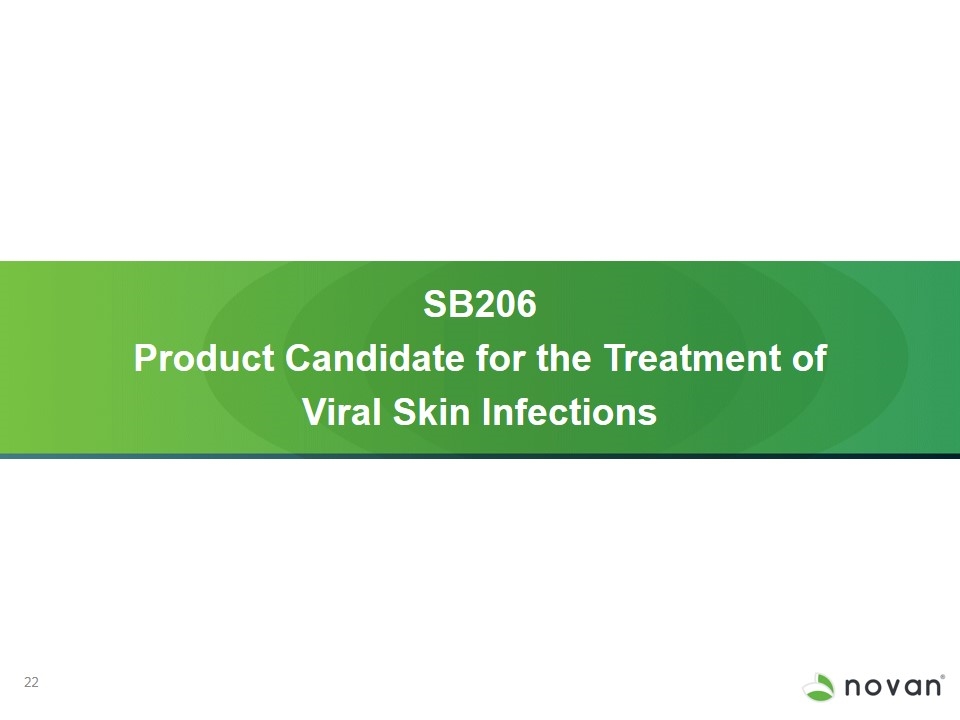
SB206 Product Candidate for the Treatment of Viral Skin Infections
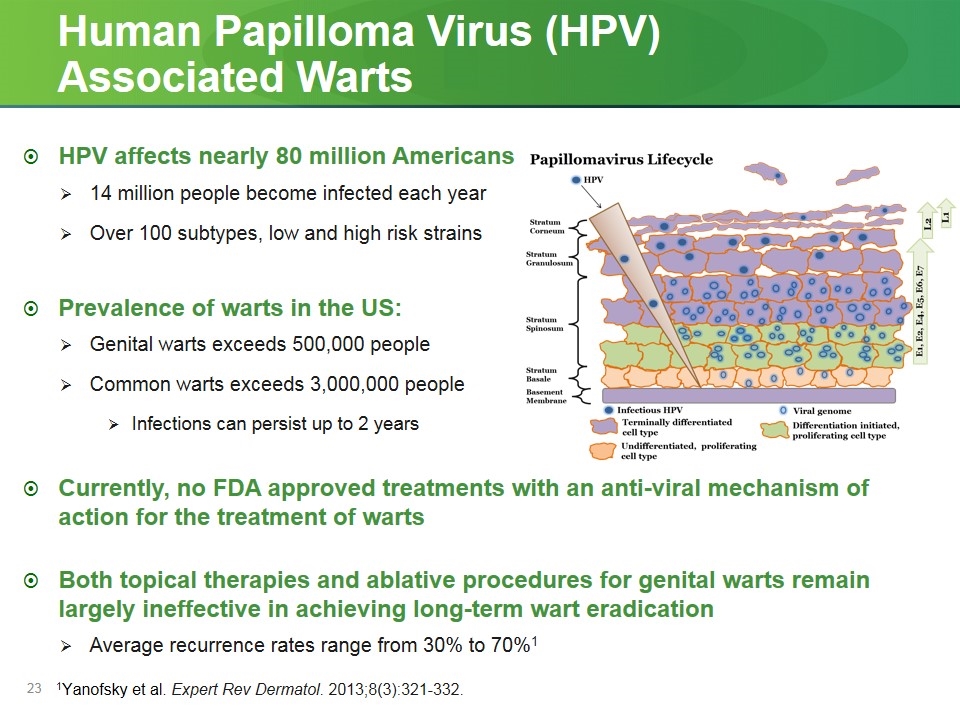
Human Papilloma Virus (HPV) Associated Warts HPV affects nearly 80 million Americans 14 million people become infected each year Over 100 subtypes, low and high risk strains Prevalence of warts in the US: Genital warts exceeds 500,000 people Common warts exceeds 3,000,000 people Infections can persist up to 2 years Currently, no FDA approved treatments with an anti-viral mechanism of action for the treatment of warts Both topical therapies and ablative procedures for genital warts remain largely ineffective in achieving long-term wart eradication Average recurrence rates range from 30% to 70%1 1Yanofsky et al. Expert Rev Dermatol. 2013;8(3):321-332.
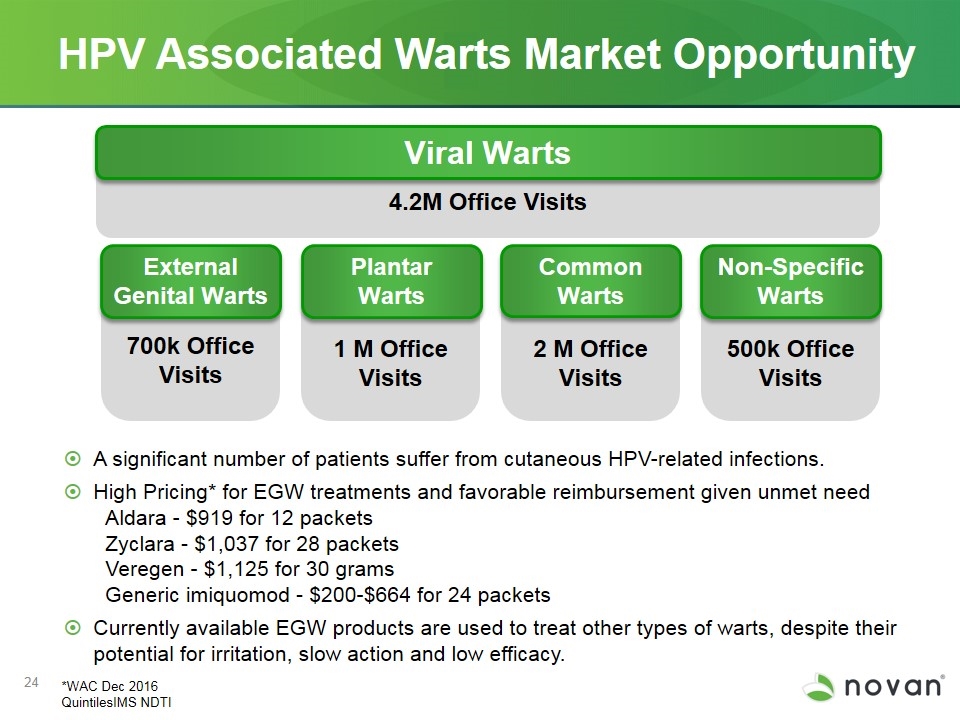
HPV Associated Warts Market Opportunity *WAC Dec 2016 QuintilesIMS NDTI A significant number of patients suffer from cutaneous HPV-related infections. High Pricing* for EGW treatments and favorable reimbursement given unmet need Aldara - $919 for 12 packets Zyclara - $1,037 for 28 packets Veregen - $1,125 for 30 grams Generic imiquomod - $200-$664 for 24 packets Currently available EGW products are used to treat other types of warts, despite their potential for irritation, slow action and low efficacy. 700k Office Visits 1 M Office Visits 2 M Office Visits 500k Office Visits External Genital Warts Plantar Warts Common Warts Non-Specific Warts 4.2M Office Visits Viral Warts
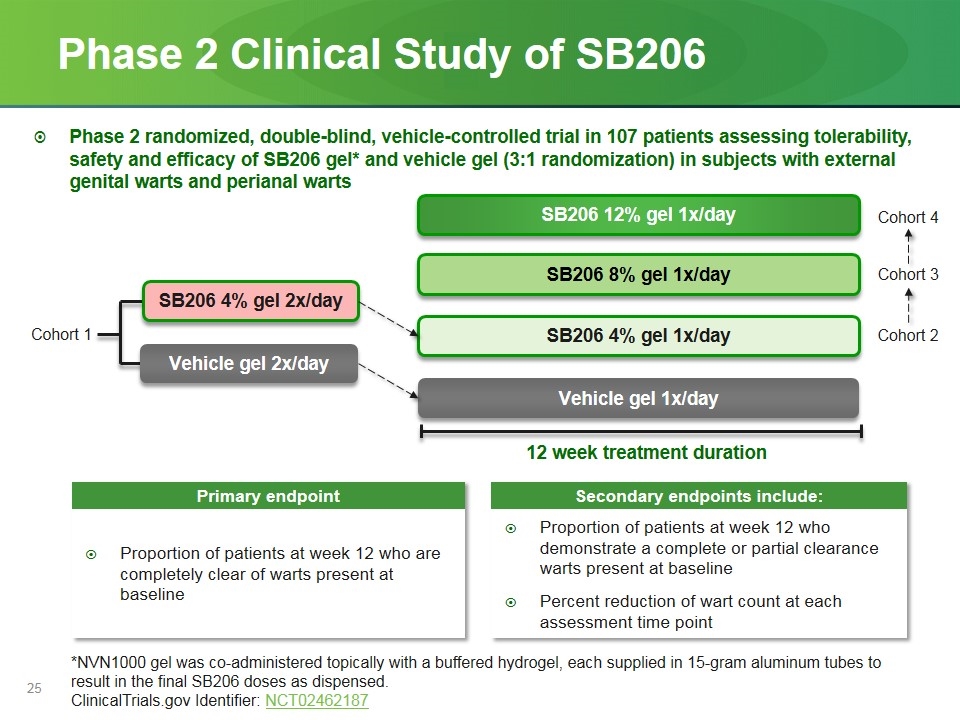
Phase 2 Clinical Study of SB206 12 week treatment duration SB206 4% gel 2x/day SB206 4% gel 1x/day Vehicle gel 1x/day SB206 8% gel 1x/day Primary endpoint Secondary endpoints include: Proportion of patients at week 12 who are completely clear of warts present at baseline Proportion of patients at week 12 who demonstrate a complete or partial clearance warts present at baseline Percent reduction of wart count at each assessment time point Phase 2 randomized, double-blind, vehicle-controlled trial in 107 patients assessing tolerability, safety and efficacy of SB206 gel* and vehicle gel (3:1 randomization) in subjects with external genital warts and perianal warts SB206 12% gel 1x/day *NVN1000 gel was co-administered topically with a buffered hydrogel, each supplied in 15-gram aluminum tubes to result in the final SB206 doses as dispensed. ClinicalTrials.gov Identifier: NCT02462187 Vehicle gel 2x/day Cohort 1 Cohort 2 Cohort 3 Cohort 4
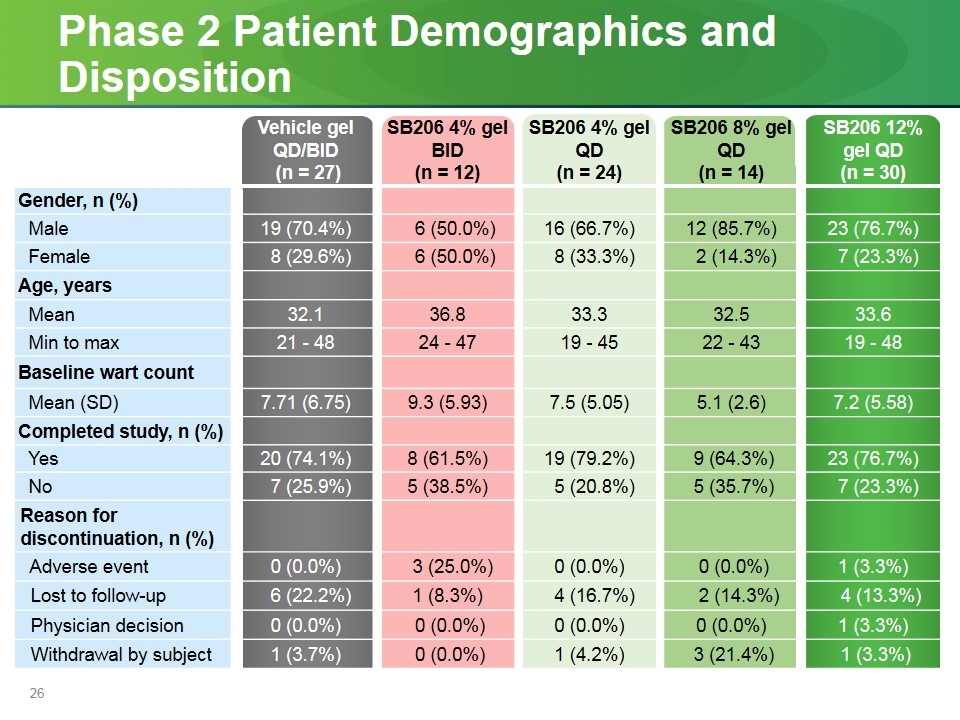
Phase 2 Patient Demographics and Disposition Vehicle gel QD/BID (n = 27) SB206 4% gel BID (n = 12) SB206 4% gel QD (n = 24) SB206 8% gel QD (n = 14) SB206 12% gel QD (n = 30) Gender, n (%) Male 19 (70.4%) 6 (50.0%) 16 (66.7%) 12 (85.7%) 23 (76.7%) Female 8 (29.6%) 6 (50.0%) 8 (33.3%) 2 (14.3%) 7 (23.3%) Age, years Mean 32.1 36.8 33.3 32.5 33.6 Min to max 21 - 48 24 - 47 19 - 45 22 - 43 19 - 48 Baseline wart count Mean (SD) 7.71 (6.75) 9.3 (5.93) 7.5 (5.05) 5.1 (2.6) 7.2 (5.58) Completed study, n (%) Yes 20 (74.1%) 8 (61.5%) 19 (79.2%) 9 (64.3%) 23 (76.7%) No 7 (25.9%) 5 (38.5%) 5 (20.8%) 5 (35.7%) 7 (23.3%) Reason for discontinuation, n (%) Adverse event 0 (0.0%) 3 (25.0%) 0 (0.0%) 0 (0.0%) 1 (3.3%) Lost to follow-up 6 (22.2%) 1 (8.3%) 4 (16.7%) 2 (14.3%) 4 (13.3%) Physician decision 0 (0.0%) 0 (0.0%) 0 (0.0%) 0 (0.0%) 1 (3.3%) Withdrawal by subject 1 (3.7%) 0 (0.0%) 1 (4.2%) 3 (21.4%) 1 (3.3%)
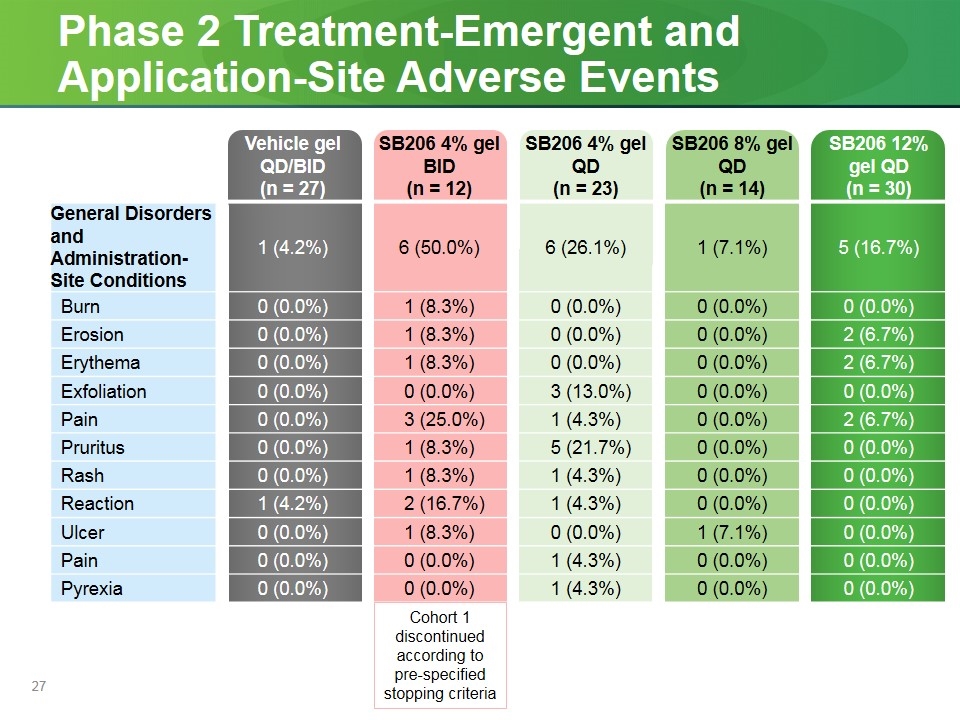
Phase 2 Treatment-Emergent and Application-Site Adverse Events Vehicle gel QD/BID (n = 27) SB206 4% gel BID (n = 12) SB206 4% gel QD (n = 23) SB206 8% gel QD (n = 14) SB206 12% gel QD (n = 30) General Disorders and Administration-Site Conditions 1 (4.2%) 6 (50.0%) 6 (26.1%) 1 (7.1%) 5 (16.7%) Burn 0 (0.0%) 1 (8.3%) 0 (0.0%) 0 (0.0%) 0 (0.0%) Erosion 0 (0.0%) 1 (8.3%) 0 (0.0%) 0 (0.0%) 2 (6.7%) Erythema 0 (0.0%) 1 (8.3%) 0 (0.0%) 0 (0.0%) 2 (6.7%) Exfoliation 0 (0.0%) 0 (0.0%) 3 (13.0%) 0 (0.0%) 0 (0.0%) Pain 0 (0.0%) 3 (25.0%) 1 (4.3%) 0 (0.0%) 2 (6.7%) Pruritus 0 (0.0%) 1 (8.3%) 5 (21.7%) 0 (0.0%) 0 (0.0%) Rash 0 (0.0%) 1 (8.3%) 1 (4.3%) 0 (0.0%) 0 (0.0%) Reaction 1 (4.2%) 2 (16.7%) 1 (4.3%) 0 (0.0%) 0 (0.0%) Ulcer 0 (0.0%) 1 (8.3%) 0 (0.0%) 1 (7.1%) 0 (0.0%) Pain 0 (0.0%) 0 (0.0%) 1 (4.3%) 0 (0.0%) 0 (0.0%) Pyrexia 0 (0.0%) 0 (0.0%) 1 (4.3%) 0 (0.0%) 0 (0.0%) Cohort 1 discontinued according to pre-specified stopping criteria
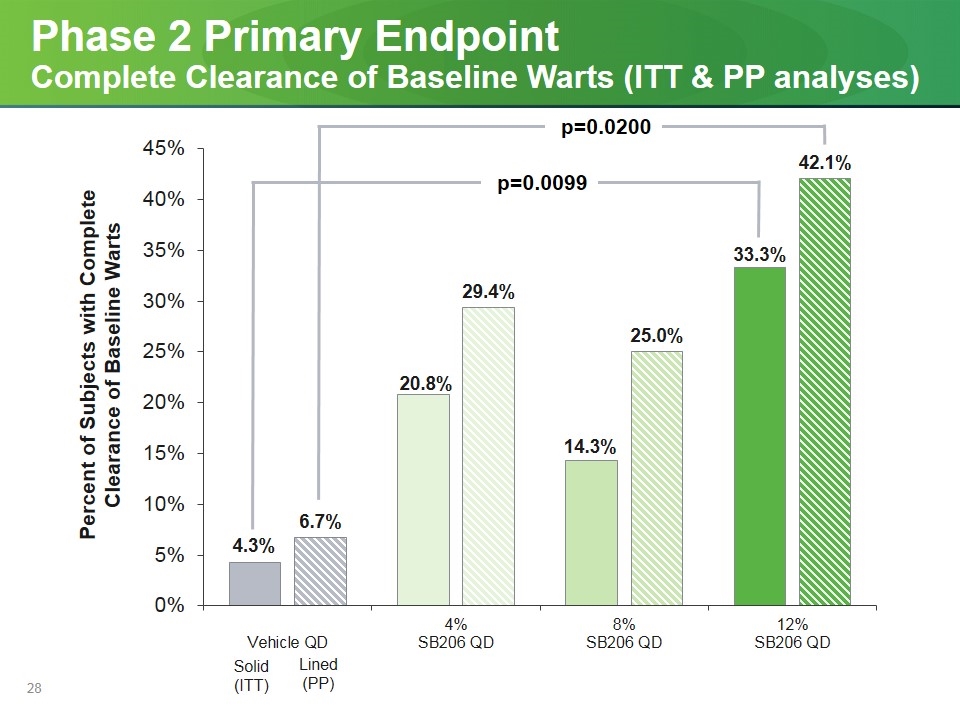
Phase 2 Primary Endpoint Complete Clearance of Baseline Warts (ITT & PP analyses) p=0.0099 p=0.0200 Solid (ITT) Lined (PP)
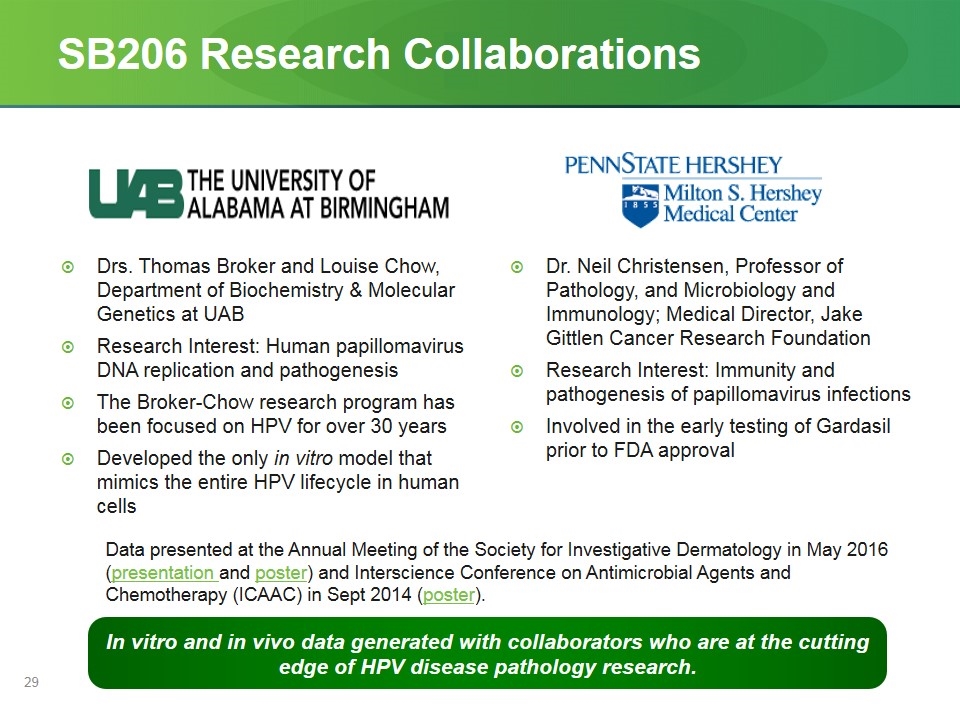
SB206 Research Collaborations In vitro and in vivo data generated with collaborators who are at the cutting edge of HPV disease pathology research. Dr. Neil Christensen, Professor of Pathology, and Microbiology and Immunology; Medical Director, Jake Gittlen Cancer Research Foundation Research Interest: Immunity and pathogenesis of papillomavirus infections Involved in the early testing of Gardasil prior to FDA approval Drs. Thomas Broker and Louise Chow, Department of Biochemistry & Molecular Genetics at UAB Research Interest: Human papillomavirus DNA replication and pathogenesis The Broker-Chow research program has been focused on HPV for over 30 years Developed the only in vitro model that mimics the entire HPV lifecycle in human cells Data presented at the Annual Meeting of the Society for Investigative Dermatology in May 2016 (presentation and poster) and Interscience Conference on Antimicrobial Agents and Chemotherapy (ICAAC) in Sept 2014 (poster).
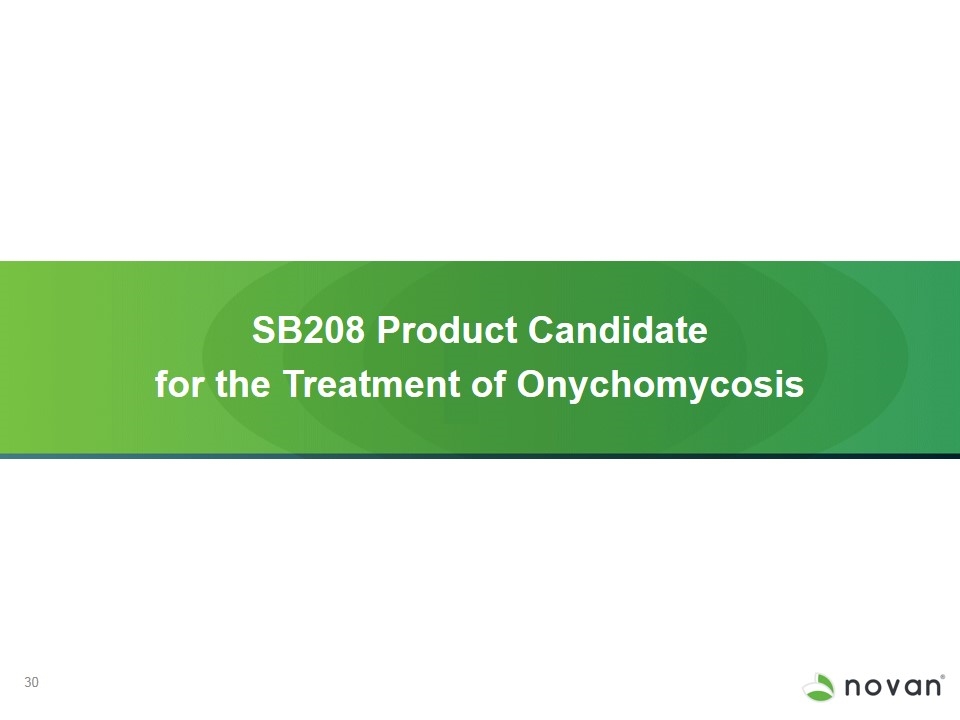
SB208 Product Candidate for the Treatment of Onychomycosis
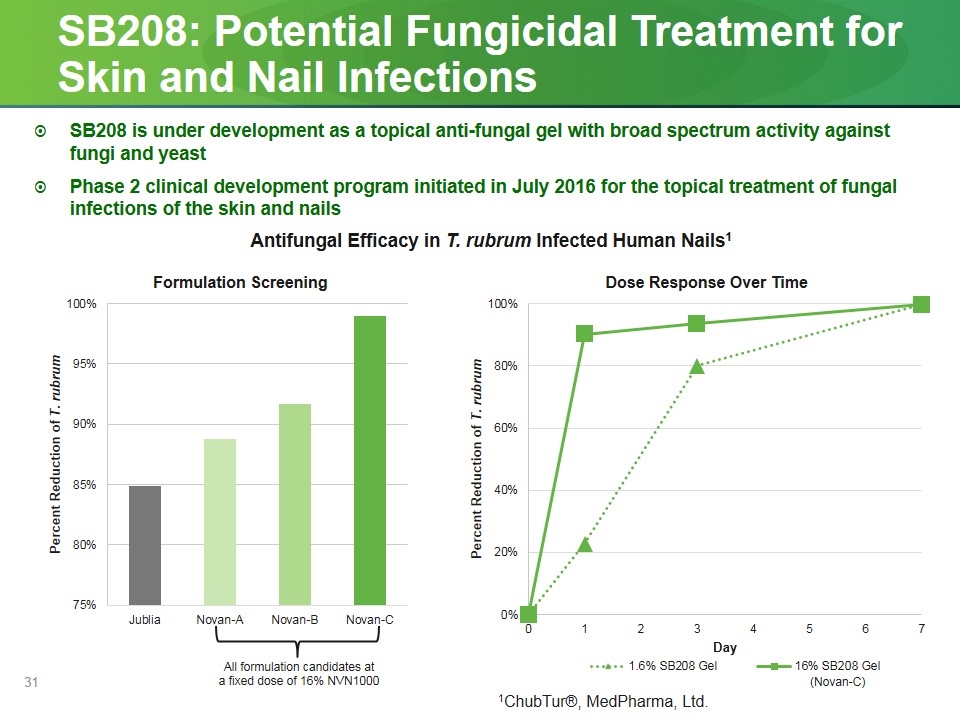
SB208: Potential Fungicidal Treatment for Skin and Nail Infections All formulation candidates at a fixed dose of 16% NVN1000 Antifungal Efficacy in T. rubrum Infected Human Nails1 SB208 is under development as a topical anti-fungal gel with broad spectrum activity against fungi and yeast Phase 2 clinical development program initiated in July 2016 for the topical treatment of fungal infections of the skin and nails Formulation Screening Dose Response Over Time 1ChubTur®, MedPharma, Ltd. (Novan-C)

Forecasted SB208 Development Program 6 Week Endpoints 52 Week Endpoints Safety and tolerability Clinical cure defined as absence of erythema, scaling and pruritus Mycological cure defined as negative KOH and negative culture Safety and tolerability Complete cure defined as 0% clinical involvement of the target toenail plus negative KOH and negative culture. Complete or almost complete cure defined as ≤5% affected target toenail area involved and negative KOH and culture. Mycological cure defined as negative KOH and negative culture Targeted Enrollment (N = 170) SB208 2% QD Vehicle SB208 4% QD SB208 16% QD Vehicle SB208 Dose Y SB208 Dose X Vehicle SB208 Dose X Phase 2 Tinea pedis Phase 2 Onychomycosis Phase 3 Onychomycosis Targeted Enrollment (N = 150) Targeted Enrollment (TBD)
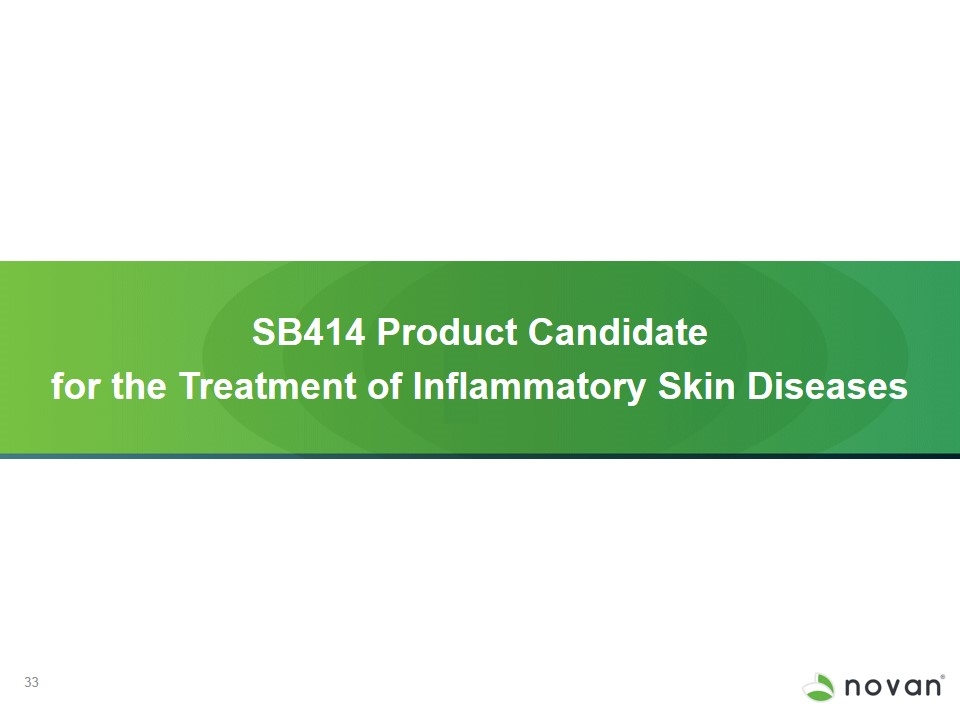
SB414 Product Candidate for the Treatment of Inflammatory Skin Diseases
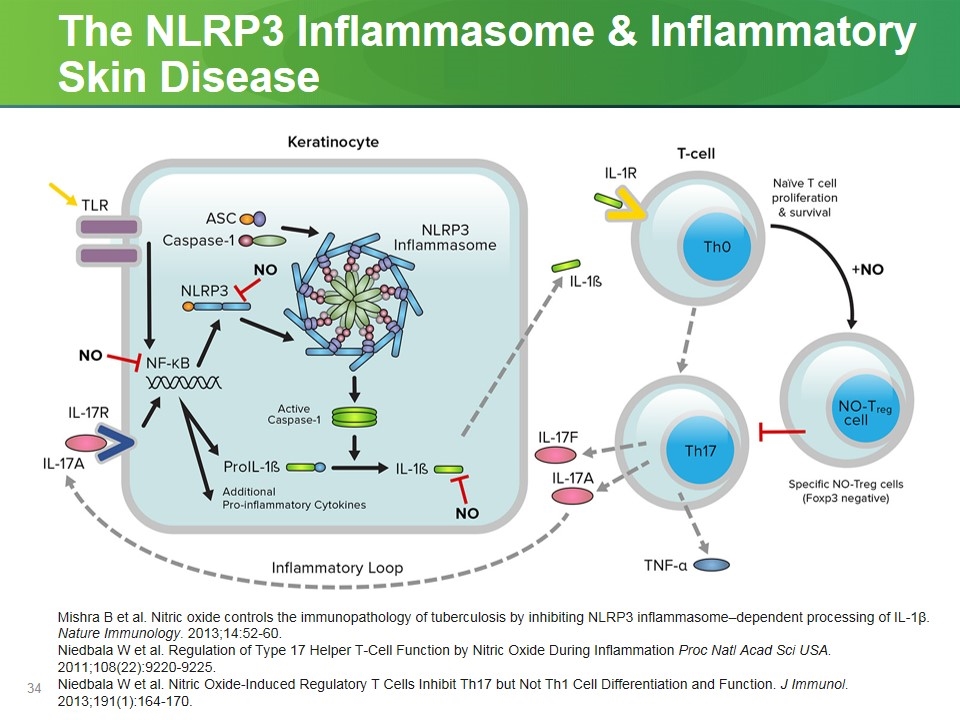
The NLRP3 Inflammasome & Inflammatory Skin Disease Mishra B et al. Nitric oxide controls the immunopathology of tuberculosis by inhibiting NLRP3 inflammasome–dependent processing of IL-1β. Nature Immunology. 2013;14:52-60. Niedbala W et al. Regulation of Type 17 Helper T-Cell Function by Nitric Oxide During Inflammation Proc Natl Acad Sci USA. 2011;108(22):9220-9225. Niedbala W et al. Nitric Oxide-Induced Regulatory T Cells Inhibit Th17 but Not Th1 Cell Differentiation and Function. J Immunol. 2013;191(1):164-170.
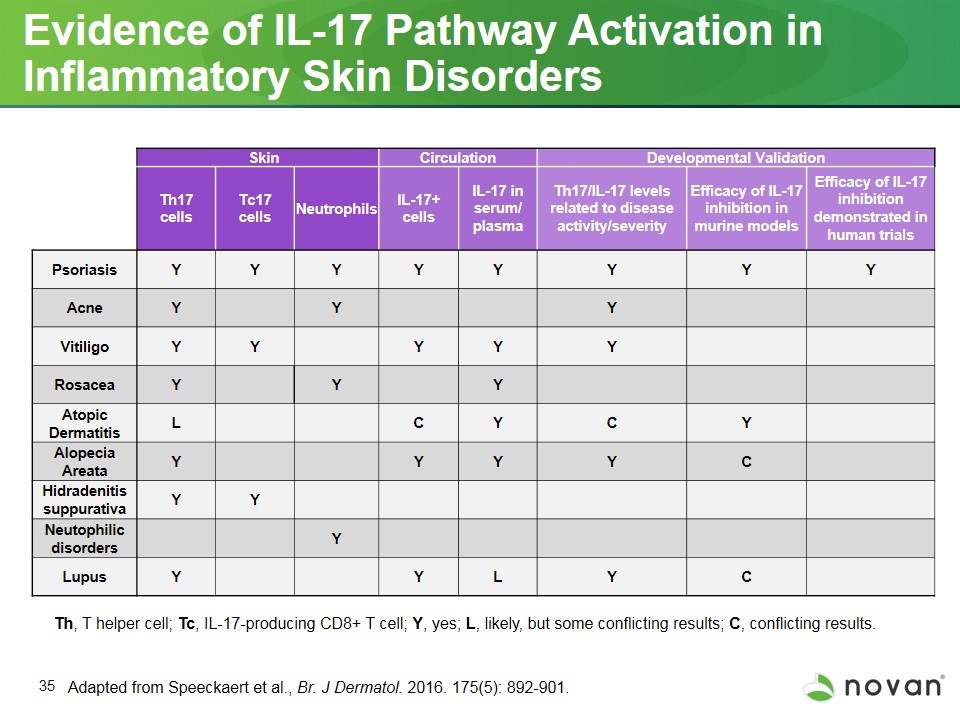
Evidence of IL-17 Pathway Activation in Inflammatory Skin Disorders Th, T helper cell; Tc, IL-17-producing CD8+ T cell; Y, yes; L, likely, but some conflicting results; C, conflicting results. Skin Circulation Developmental Validation Th17 cells Tc17 cells Neutrophils IL-17+ cells IL-17 in serum/ plasma Th17/IL-17 levels related to disease activity/severity Efficacy of IL-17 inhibition in murine models Efficacy of IL-17 inhibition demonstrated in human trials Psoriasis Y Y Y Y Y Y Y Y Acne Y Y Y Vitiligo Y Y Y Y Y Rosacea Y Y Y Atopic Dermatitis L C Y C Y Alopecia Areata Y Y Y Y C Hidradenitis suppurativa Y Y Neutophilic disorders Y Lupus Y Y L Y C Adapted from Speeckaert et al., Br. J Dermatol. 2016. 175(5): 892-901.
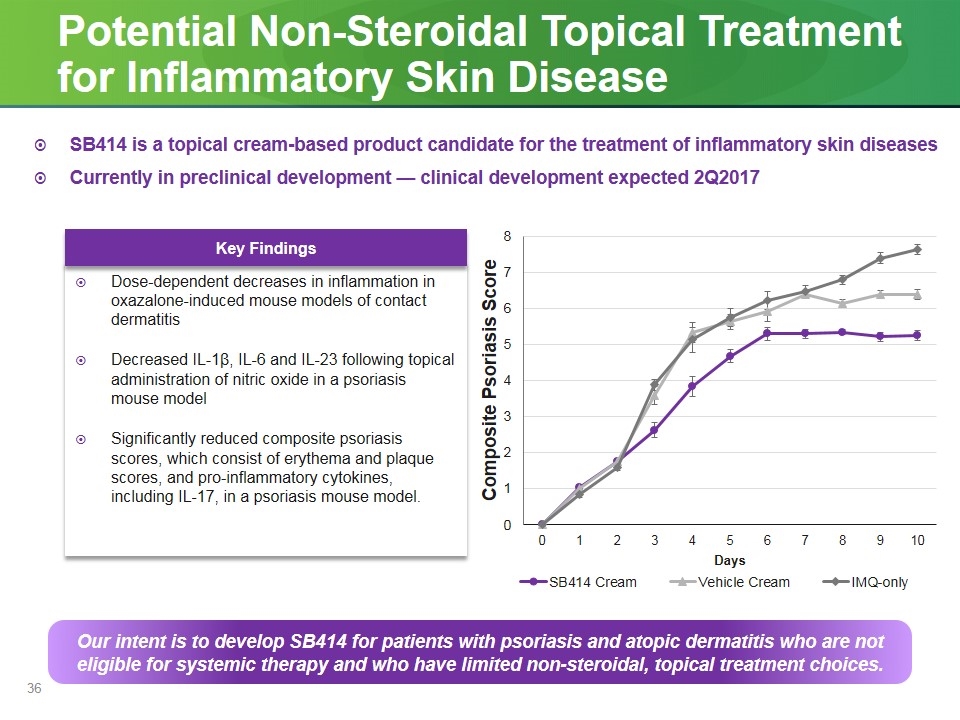
Potential Non-Steroidal Topical Treatment for Inflammatory Skin Disease Our intent is to develop SB414 for patients with psoriasis and atopic dermatitis who are not eligible for systemic therapy and who have limited non-steroidal, topical treatment choices. Key Findings Dose-dependent decreases in inflammation in oxazalone-induced mouse models of contact dermatitis Decreased IL-1β, IL-6 and IL-23 following topical administration of nitric oxide in a psoriasis mouse model Significantly reduced composite psoriasis scores, which consist of erythema and plaque scores, and pro-inflammatory cytokines, including IL-17, in a psoriasis mouse model. SB414 is a topical cream-based product candidate for the treatment of inflammatory skin diseases Currently in preclinical development — clinical development expected 2Q2017
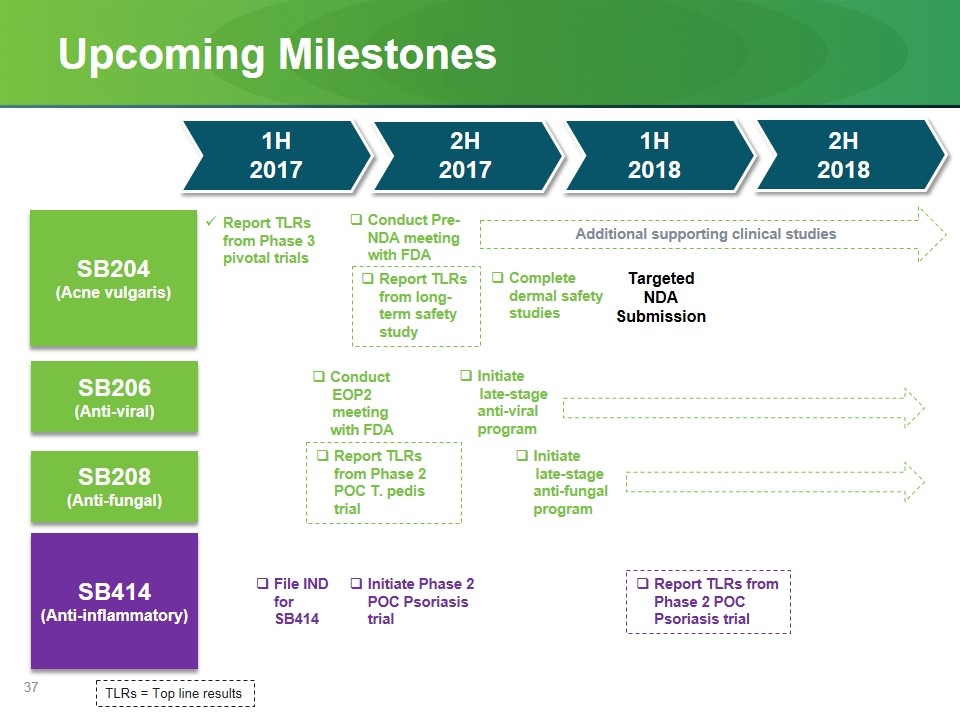
Upcoming Milestones SB204 (Acne vulgaris) SB206 (Anti-viral) SB208 (Anti-fungal) Targeted NDA Submission Report TLRs from long-term safety study Report TLRs from Phase 3 pivotal trials TLRs = Top line results Report TLRs from Phase 2 POC T. pedis trial Conduct EOP2 meeting with FDA Complete dermal safety studies 1H 2017 1H 2017 2H 2017 1H 2018 2H 2017 SB414 (Anti-inflammatory) Report TLRs from Phase 2 POC Psoriasis trial 2H 2018 Initiate Phase 2 POC Psoriasis trial Initiate late-stage anti-viral program File IND for SB414 Initiate late-stage anti-fungal program Additional supporting clinical studies Conduct Pre-NDA meeting with FDA




































